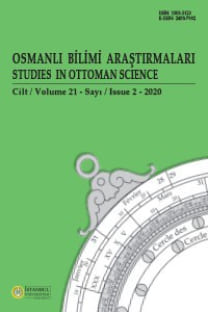Dünden Bugüne Kündürün Tedavideki Yeri
Kündür [Boswellia] Afrika, Arabistan yarımadasının güney bölgelerinde ve Hindistan’ın doğusunda kuru, verimsiz, kayalık bölgelerinde yetişen ince kabuklu bir ağaç türüdür. Kündür, çeşitli farmakolojik kullanımları olan, özellikle anti-inflamatuar etkisi ile tanınan kokulu bir reçineye sahiptir. Mısırlılar, Sümerler, Persler, Romalılar ve diğer uygarlıklar bu ağacı bilmekteydiler. Reçinesini (olibanum) tapınaklarda, dini ayinlerde yakmakta ve bununla genellikle çeşitli ilaç ve merhemler hazırlamaktaydılar. Günümüzde Hint kündürü morbus Crohn, ülseratif kolit veya poliartrit gibi kronik bazı hastalıklarda alternatif ilaç olarak denenmeye başlanmıştır. Melanom, glioblastom ve karaciğer karzinomunda AKBA pozitif sonuçlar göstererek tümör hücrelerinin azalıp yok olması kanıtlanmıştır. Ama bu çalışmalar çok dar kapsamlıdır.
Anahtar Kelimeler:
Kündür, Hippocrates, Galen, Dioscorides, Rhazes, Avicenna, AKBA.
Treatment with Boswellia from past to present
Boswellia is a genus of trees known for their fragrant resin which has many pharmacological uses particularly as anti-inflammatories. This tree grows in Africa, Arabian Peninsula and India’s dry, arid, rocky regions. Egyptians, Sumerians, Babylonians, Persians, Romans and many other civilizations knew that tree. They burned the resin (olibanum) of the Boswellia by religious rituals in temples and usually used in making a variety of drugs and ointments. Nowadays, people use Indian boswellia as alternative medicine by treatment of morbus Crohn, ulcerative colitis, bronchial asthma, rheumatoid arthritis or polyarthritis. In melanoma, glioblastomas and liver cancer olibanum derivatives show positive results in the reduction and destruction of tumor cells. But these studies are too narrowly.
Keywords:
Boswellia, Hippocrates, Galen, Dioscorides, Rhazes, Avicenna, AKBA,
___
- 1. Pahlow, M., Das groβe Buch der Heilpflanzen. Augsburg, 2006, s.465.
- 2. Khare, C.P., Indian Herbal Remedies. Heidelberg, 2004, s.108-109.
- 3. Kluge, H., Fernando, C.R., Winking, M., Weihrauch und seine heilende Wirkung. Stuttgart, 2005, s.16.
- 4. Christof, K. D., Haass, R., Weihrauch. Der Duft des Himmels. Dettelbach. 2006, s.101-118.
- 5. Raunig, W., Bernstein – Weihrauch - Seide: Waren und Wege der antiken Welt. Wien, 1971, s.47-51.
- 6. Kluge, H., Fernando, C. R., Winking, M., Weihrauch und seine heilende Wirkung. Stuttgart, 2005, s.18.
- 7. Sontheimer, J., Große Zusammenstellung über die Kräfte der bekannten einfachen Heil- und Nahrungsmittel von Abu Mohammed Abdallah Ben Ahmed aus Malaga bekannt unter den Namen Ebn Baithar, II.Band Stuttgart, 1840, s.398-399.
- 8. Acıduman, A., Uygur, E., Belen, D., “Osmanlı döneminden “Yazarı Bilinmeyen Cerrâhnâme” ve nöroşirürji ile ilgili bölümleri,” Türk Nöroşirürji Dergisi, 2007, c.17, sayı 3, s.164.
- 9. Bizantion’dan İstanbul’a Bir Başkentin 8000 Yılı. İstanbul, 2010, s.152. 10. Ünver, A. S., İslam Tababetinde Türk Hekimlerinin Mevkii ve İbni Sina’nın Türklü ğ ü. Belleten, c.1, sayı 1, 1995, s.271-272.
- 11. Sharifabad, M. H., Esfandiary, E., Alaei, H., “Effects of Boswellia serrata aqueous extract during lactation on increasing power of learning and memory in adult offsprings,” Phytopharmaka und Phytotherapie. Gemeinsame Tagung der Deutschen Gesellschaft für klinische Pharmakologie und Therapie, der Gesellschaft für Phytotherapie und der Gesellschaft für Arzneipflanzenforschung. Berlin, 26.- 28.2.2004. Abstract-Band, s.86.
- 12. Kluge, H., Fernando, C.R., Winking, M., Weihrauch und seine heilende Wirkung. Stuttgart, 2005, s.38.
- 13. Gerhardt H., Seifert F., Buvari P., Vogelsang H., Repges R., “Therapie des aktiven Morbus Crohn mit dem Boswellia-serrata-Extrakt H15,” Zeitschrift der Gastroenterologie, 39 (2001):11-7.
- 14.Rahman, A., Bioactive Natural Products. Part C, Vol 22, Amsterdam, 2000, s.110, 116, 120.
- 15. Warnke et al., “Die Rolle von Boswellia-Säuren in der Therapie maligner Gliome: Methodische Mängel,”. Deutsches Ärzteblatt 1998; 95:A-220.
- 16. Moussaieff, A. et al., “Incensole acetate, an incense component, elicits psychoactivity by activating TRPV3 channels in the brain,” The FASB Journal, 2008, 22(8):3024-3034.
- 17. Frank, M.B. et al., “Frankincense oil derived from Boswellia carteri induces tumor cell specific cytotoxicity,” BMC Complement Altern Med. 2009, 8(9):6
- ISSN: 1303-3123
- Yayın Aralığı: Yılda 2 Sayı
- Başlangıç: 1995
- Yayıncı: İstanbul Üniversitesi Edebiyat Fakültesi
Sayıdaki Diğer Makaleler
Tarihi ‘Sıhhat Eczanesi’ Anadolu Üniversitesi Eczacılık Fakültesi’nde
Tolga eczanesi: Ecz. Murat Özdoğan’ın Türk eczacılık tarihi koleksiyonu
Dünden Bugüne Kündürün Tedavideki Yeri
Osmanlı’dan günümüze eczacının değişen konumu
Elma şarabının (Elma Şırası) tıbbi kullanımı: Tarihsel bir derleme
Unutulan galenik şekiller ve ilaçlar
Toptaşı Bimarhanesi Eczanesi son dönemi 1913–1927
Türkiye’de bulunan bazı devlet arşivleri ve eczacılık tarihi açısından önemi
